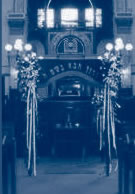|
SEDRA : Bereishit Hertz Chumash p. 2 Genesis
Chap 1 verse 1
This week's Sedra is generously sponsored by Kerry Klineberg.
SYNOPSIS:
Parashat Bereshit deals with the creation of the world - "Maase
Bereshit" - which summarises the events of the Creation
of the Universe.
The opening verse is followed by a narrative of the things
G-d created on each of the six days of creation.
On the first day He created light.
On the second day He created the sky, known as the firmament
or skyline, to separate the waters above (mist, rain) and
the waters below (i.e. seas, lakes, rivers).
On the third day the waters below gathered into one place
and the earth produced vegetation.
On the fourth day G-d created the luminaries -- the sun, moon
and stars.
On the fifth day He created reptiles, birds and fish.
On the sixth day, land animals and humans were created. G-d
gave man power to rule over all living things and permitted
man, animal, beast and bird to feed and to be sustained on
vegetation. Each of the above sections concludes with the
expression, "And it was evening and it was morning...day".
At the conclusion of the six days of work and creative activity,
that is, on the seventh day, G-d rested. He blessed the seventh
day and declared it holy.
The narrative of the creation is followed by the story of
the Garden of Eden and a short description detailing the creation
of man. After the description of the Garden of Eden, we are
told that G-d gave man permission to eat of the fruit of every
tree in the garden, except the fruit of the Tree of Knowledge.
We also read of the creation of woman, who is to be man's
partner. Genesis Ch.3 contains the story of man's fall from
G-d's grace. The serpent enticed Eve to eat from the forbidden
fruit of the Tree of Knowledge of Good and Evil. She gave
Adam of the fruit, and he too ate. The first result of this
action was for Eve and Adam to realise that they were naked.
G-d punished all three parties for disobeying the divine prohibition.
G-d provided man and woman with leather clothing and banished
Adam and Eve from the Garden of Eden, preventing them from
ever returning there.
After their expulsion from Eden, Adam and Eve became parents
of two sons, Cain and Abel. Cain murdered Abel. He was duly
punished by G-d. The story is followed by an account of the
descendants of Cain, among whom was Lemech.
The Torah then relates the birth of the third son of Adam
and Eve, named Sheth, and his son Enoch. This is followed
by a genealogy which lists the ten generations from Adam to
Noah. One person is mentioned in every generation -- his age,
when he had his first son, and how many years the father lived
after the birth of his son. We are informed that each father
had other sons and daughters and of his age at death.
At the end of the Parasha there appears an obscure account
about the Sons of G-d, the daughters of man and the Nephilim.
The remaining verses are a prelude to the forthcoming deluge
-- G-d despairing of His creation, given man's evil nature,
plans to blot our mankind. We are told earlier, however, of
the birth of Noah, which introduced an element of comfort
(hence Noah), into a cosmos of so much disharmony. Noah is
singled out as a man who found favour in G-d's eyes. (Adapted
from: "Genesis" teaching Guide by Mena Kozminsky
(now Meyerowitz).
HAPHTORAH HERTZ CHUMASH P. 21 Isaiah Chap 42 verse 5
The Sedra deals with the Creation of Man in G-d's image i.e.
with a Divine Soul. The Haphtorah reveals that all mankind
has a soul. Israel's uniqueness is its role as the Servants
of G-d and as an educational rolemodel to the nations.
This task is elaborated in the Haphtorah by its author, Isaiah.
TELL ME RABBI .... I'VE BEEN OFFERED AN ALIYAH
The honour of reciting the blessings over the Torah is called
an aliyah, which means "going up". The person honoured
ascends or goes up to the bimah where the Torah is read. This
also represents a spiritual ascent. Several occasions in life
are traditionally appropriate for an aliyah and are made more
significant by this honour. They include one's Barmitzvah,
before one gets married (aufruff), naming a baby daughter,
and one observing a yahrzeit.
An aliyah to mark a birthday, anniversary, recovery from a
sickness, or when one wants to recite the "gomel"
blessing is also appropriate. Synagogues try to be accommodating
where possible.
On Monday and Thursday mornings, on Shabbat and Yom Kippur
afternoon, as well as on Channukah, Purim, and all fast days,
the Torah reading is divided into three portions, or "aliyot".
On Rosh Hodesh and on the intermediate days of Pesach and
Succot (chol hamoed), four people are called up.
On the festival days of Pesach, Shavuot and Succot and on
Rosh Hashannah, the Torah reading is divided into five aliyot.
On Yom Kippur morning there are six aliyot.
On Shabbat the Torah reading is divided into seven aliyot.
It is not permissible to call up fewer than the prescribed
number. Except for Shabbat (and Simchat Torah), it is not
usual to add to the prescribed number.
Since Jewish law permits more than seven aliyot on the Shabbat,
some Congregations call up more than seven men. Some Synagogues
disallow this practice because it lengthens the service.
Our Shule allows a limited number of additional Aliyot.
The first aliyah is always given to a Kohen (one of priestly
descent), if one is present. The Mishnah cites the "ways
of peace" as the reason for this practice. There is also
a Torah requirement "to sanctify him" (Lev. 21:8)
giving the Kohen priority in sacred matters.
The second aliyah is then given to a Levite.
The remaining aliyot are distributed among the rest of the
Congregation classified as "Israelites".
The names of the other aliyot are really the Hebrew words
for the ordinal numbers. Shlishi ("third"), Revi'i
("fourth"), Hamishi ("fifth"), Shishi
("sixth"), Shvi'i ("seventh"). Each additional
aliyah is called hosafah "additional" and the very
last hosafah is called aharon ("last").
CORRECT PROCEDURE FOR THE ALIYAH.
* Hasten to go up to the Torah. The Torah Reader points to
where he will begin to read. With the edge of your tallit,
touch the scroll or where the reading begins and kiss the
Tallit lightly. Stand in front of the Torah grasping it with
the two handles (called Eitz Chayim - Tree of Life) projecting
from the bottom of the scroll.
* Keep the scroll closed and begin the Bracha. The Congregation
respond and you repeat it. Open the scroll as you come to
the end of the blessing. After the reading you recite the
second blessing, another person is called up to the Torah.
You are then asked your name and a personalised blessing (MiSheberach)
is made on your behalf. Traditionally a donation to the Synagogue
is pledged at this point linking G-d's blessing with a demonstration
of your own generosity.
* At this time a special Mi She'beirach prayer may be recited
to name a baby or for the recovery of a sick person. Provide
the person's Hebrew name and that of his or her mother. Apparently,
a mother's prayer is considered more sincere and more likely
to be favourably received ( Psalms 116:16, where David beseeches
G-d saying, "I am Thy servant, the son of Thy maidservant").
* Remain on the bimah until the person who receives the next
aliyah completes the second blessing. Return slowly to your
seat.
* We usually ascend the bimah from the right side and descend
from the left. (Temple practice was ascent to the altar from
the right and descend from the left (Zevahim 63a, b). A parallel
tradition: hasten by the shortest possible route to the bimah
to show respect for the Torah (regardless of whether it means
going up by left or right) and return to your seat by the
longest route symbolising reluctance to leave the Torah. Priority
is given to the shorter route, even if it means ascending
from the left (OH 141:7).
We always leave or descend from the opposite side to the one
used going up.
BACK TO SHABBAT SHALOM
TABLE
|








